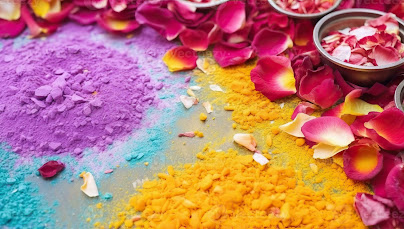Natural colors for Holi, safe for the skin and the environment
Natural Holi colors are derived from organic, plant-based, or mineral sources. These eco-friendly colors are made to minimize harm to the skin, eyes, and environment.
Natural colors for Holi are made from organic and eco-friendly sources, designed to be safe for the skin and the environment.
Here's a basic description of the most common colors and their sources:
Red: Often made from red sandalwood, hibiscus flowers, or beetroot powder. Derived from dried hibiscus flowers, red sandalwood, or beetroot powder. These are bright and vibrant without harmful chemicals.
Yellow: Created using turmeric (haldi) or marigold flowers. Sometimes, ground gram flour (besan) is mixed with turmeric to create a lighter yellow. Made from turmeric (haldi) or marigold flowers, sometimes mixed with flour like gram flour (besan) for a lighter shade.
Green: Extracted from henna leaves (mehendi) or spinach. Other green plants like neem leaves can also be used. Comes from henna (mehendi) leaves, spinach, or neem leaves. These plant-based sources give a soft, earthy green hue.
Blue: Sourced from indigo plants or blue hibiscus. Extracted from indigo plants or jacaranda flowers, providing a deep blue color naturally.
Pink/Magenta: Made from beetroot juice or rose petals. Created using beetroot juice or rose petals, giving a bright and soft pink color.
Orange: Sourced from palash flowers (flame of the forest), which provide a beautiful orange shade.
These natural colours are biodegradable, non-toxic, and gentle on the skin. Unlike synthetic colors, they don’t contain harmful chemicals, making them a safer choice for Holi celebrations.
These Natural Holi colours are non-toxic, biodegradable, and gentle on the skin, making them a safe alternative to synthetic Holi colors.





Comments
Post a Comment